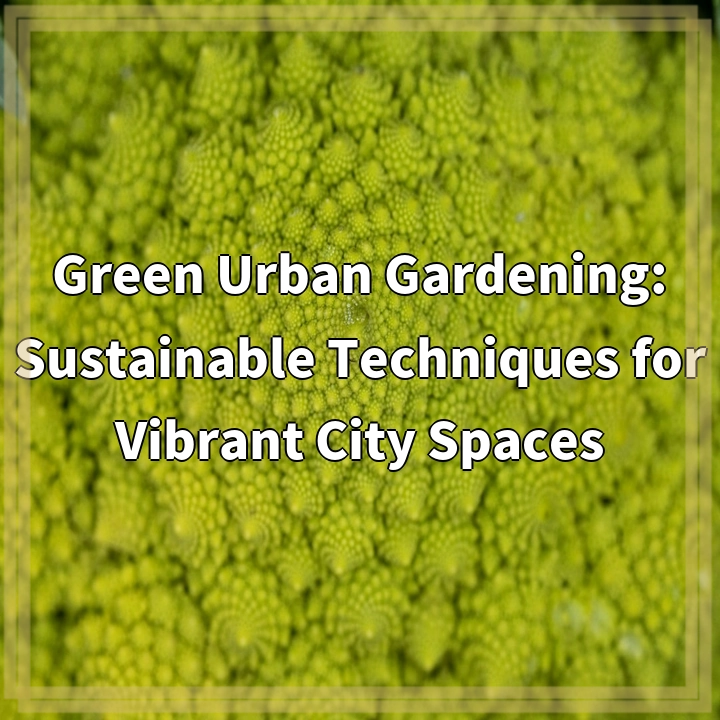Physical Address
304 North Cardinal St.
Dorchester Center, MA 02124
Physical Address
304 North Cardinal St.
Dorchester Center, MA 02124

Green Urban Gardening refers to the practice of creating and maintaining gardens in urban areas, such as cities and towns. This sustainable gardening technique aims to transform vacant spaces, rooftops, balconies, and even vertical structures into lush green areas that provide numerous benefits for both people and the environment.
1. Limited Space
One of the main challenges with urban gardening is the limited space available. Urban areas are often densely populated, leaving little room for traditional outdoor gardens. As a result, gardeners have to get creative and utilize vertical gardening techniques, rooftop gardens, and community gardens to maximize the available space and grow a wide variety of plants.
2. Soil Quality
In urban environments, the quality of the soil can be a significant issue. Soil in cities is often contaminated with pollutants, chemicals, and heavy metals, making it unsuitable for growing healthy plants. Urban gardeners need to take soil testing and remediation measures to ensure the soil is safe and fertile for growing plants.
3. Limited Access to Sunlight
Buildings, tall structures, and shading from nearby structures can limit the amount of sunlight that reaches urban gardens. Lack of sufficient sunlight can negatively impact plant growth and limit the types of plants that can thrive. Urban gardeners need to carefully plan their garden layout, considering sun exposure and incorporating techniques like reflective surfaces or installing artificial lights to supplement natural light.
4. Water Availability and Management
Water scarcity is a global concern, and urban areas are no exception to this challenge. Urban gardeners must pay attention to water availability and efficient water management techniques. These can include installing rainwater harvesting systems, using drip irrigation or watering timers to minimize water waste, and selecting plants that are drought-tolerant and require less water.
5. Urban Heat Island Effect
Cities often experience the Urban Heat Island Effect, where concrete, asphalt, and buildings absorb and retain heat, leading to higher temperatures compared to rural areas. This increased heat poses challenges to urban gardeners as it can affect plant health. Strategies like incorporating shade structures, using reflective materials, and selecting heat-tolerant plant varieties can help mitigate the impact of urban heat on garden plants.
6. Community Engagement and Education
Encouraging community participation and educating urban residents about the benefits of green urban gardening can be a significant hurdle. Many people in cities may not have previous gardening experience or may be unaware of the positive impacts of urban gardens. Building community engagement initiatives, organizing workshops and events, and creating awareness campaigns are essential for establishing and maintaining successful urban gardening projects.
1. Vertical and Rooftop Gardening
Maximizing the use of vertical spaces and rooftops allows for more efficient use of limited space in urban areas. Implementing techniques like trellises, hanging baskets, and living walls enables gardeners to grow a larger variety of plants without requiring extensive ground space.
2. Soil Testing and Remediation
Conducting regular soil tests and implementing appropriate soil remediation measures can help address soil quality issues in urban gardens. Techniques like adding organic matter, using compost, and employing raised bed gardening can improve soil fertility and structure.
3. Artificial Lighting and Reflective Surfaces
Installing artificial lights and incorporating reflective surfaces can compensate for limited sunlight in urban gardens. This allows plants to receive adequate light for photosynthesis. LED grow lights and reflective materials can be used to optimize plant growth and yield.
4. Water Conservation and Management
To overcome water scarcity challenges, capturing rainwater and installing drip irrigation systems can be effective solutions. Mulching and using water-retaining materials in the soil can also help conserve moisture. Additionally, selecting native and drought-resistant plant species will reduce water requirements.
5. Green Infrastructure and Cool Roofs
Implementing green infrastructure initiatives, such as urban tree planting and creating green spaces, can help mitigate the urban heat island effect. Cool roofs, which reflect sunlight and absorb less heat, can be incorporated into buildings to reduce heat buildup and create a more favorable environment for urban gardens.
6. Community Engagement and Education Programs
Creating community gardens and organizing workshops, events, and educational programs can encourage community participation and awareness. By fostering a sense of ownership and providing knowledge about urban gardening benefits, more people can be motivated to participate, maintain gardens, and contribute to sustainable urban greening efforts.
Green urban gardening techniques offer solutions to the challenges faced in urban areas. By implementing these techniques, urban gardeners can create vibrant and sustainable city spaces that benefit both people and the environment.
If you’re wondering where the article came from!
#